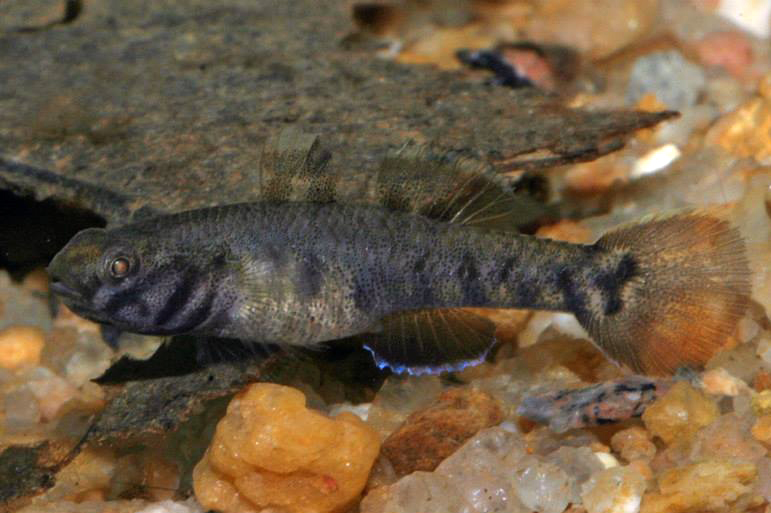Chequered Mangrovegoby, Mugilogobius mertoni (Weber 1911)
Other Names: Chequered Mangrove Goby

A Chequered Mangrovegoby, Mugilogobius mertoni, from mangroves in Darwin Harbour, Northern Territory. Source: Dave Wilson / Aquagreen. License: All rights reserved
Summary:
A small brownish, greyish-yellow to greyish-violet goby with 7 to 11 dark diagonal stripes on sides, 2-3 black spots or short stripes on caudal-fin base, first dorsal fin with a black mark and a white marginal stripe, a distinct black mark at pectoral-fin base, and head with irregular red and blue stripes.
Cite this page as:
Martin F. Gomon, Mugilogobius mertoni in Fishes of Australia, accessed 27 Jun 2025, https://fishesofaustralia.net.au/Home/species/3063
Chequered Mangrovegoby, Mugilogobius mertoni (Weber 1911)
More Info
|
Distribution |
Distributed in northern Australia from east of Darwin, NT to Townsville, QLD (19°10'S) and elsewhere in the tropical Indo-west Pacific; a benthic species on mud bottoms in estuarine and freshwater habitats. |
|
Features |
Meristic features: Dorsal fin VI-VII; I, 6-8; Anal fin I, 6-8; Caudal fin (segmented rays) 15-17, (branched rays) 13-16; Pectoral fin 14-17; TRB 8-14; Gill rakers 2-4 +7-8 = 9-13; Vertebrae 10 + 15-17 = 25-27. Body rather compressed, especially posteriorly, depth 4.4-5.9 in SL. Head broad, rounded, wider than deep, length 3.1-3.6 in SL; cheeks sometimes slightly inflated. Snout rounded. Anterior nostril in short tube at edge of preorbital directed down and forward, preorbital usually curved forward to accommodate nostril; posterior nostril oval, centre of eye at anterior margin. Eyes rather small, lateral, high on head, top usually forming part of dorsal profile, 2.8-4.3 in head. Interorbital broad, flat; top of head from rear of interorbital space forward to snout tip covered with fine, sometimes branched villi. Mouth subterminal, slightly oblique, reaching to below mid or posterior half of eye in males, and to below anterior half or middle of eye females; lips usually smooth, lower lip free at sides, fused narrowly across front; chin smooth. Tongue tip blunt or concave. Gill opening usually extending forward to under opercle; inner edge of pectoral girdle smooth with no ridge or flange, with low irregular flat or fleshy flange, or distinct fleshy knobs and/or flaps on edge. Upper jaw with outer row of teeth stout and curved and 3-4 rows of small sharp teeth behind; lower jaw with 5-6 rows of small sharp curved teeth; teeth of males slightly larger than females. Body fully scaled, ctenoid scales extending forward in broad wedge to behind pectoral fin; lateral line absent; longitudinal series 26-37; most predorsal scales of small, even size, reaching to close behind eyes, anterior 1-4 enlarged, 9-19 on dorsal midline; operculum with small cycloid scales on upper two-thirds to half; cheek naked; pectoral base and prepelvic area covered with cycloid scales; belly with isolated patch of ctenoid scales under pelvics, remainder cycloid. Head pores absent. Two separate dorsal fins; 1st low, rounded, tips of 1st 3 spines often free, 3rd spine of 1st dorsal fin most often longest; spines always falling short of second dorsal fin origin when depressed; 2nd dorsal and anal fins low, angled anteriorly, pointed posteriorly, last rays falling well short of caudal fin when depressed. Pectoral fin rounded, rays all branched except first. Pelvic fins united into complete disc, short, rounded to oval, reaching half to two-thirds distance to anus. Caudal fin rounded. |
|
Colour |
Head and anterior quarter of body grey with darker grey lines, blotches and mottling; remainder greyish yellow; side of body with two alternating rows of violet to dark grey cross-hatched bars and blotches, lower row on lateral mid line; banded form with wide purplish brown bands alternating with yellowish background; chequered form with dense mottling and banding in dark brown, forming chequered pattern; whitish abdominal wall showing through musculature; first dorsal fin sometimes with dense black spot, pale yellowish band above in some; second dorsal fin with two rows of elongate dark grey spots; pale yellowish sub-marginal band in second dorsal fin; anal and pelvic fins plain purplish; caudal fin grey with curved, comma-shaped dark grey blotch across bases of upper rays, base of fin dull yellow. |
|
Species Citation |
Gobius mertoni Weber, 1911, Abh. Senckenb. Naturforsch. Ges. 34: 37, figs 5, 6. Type locality: Panua Bori River, Gungei Manumbai, Wokam, Aru Is., Indonesia. Gangetic River region, India. |
|
Author |
Martin F. Gomon |
Chequered Mangrovegoby, Mugilogobius mertoni (Weber 1911)
References
Huckstorf, V. 2012. Mugilogobius mertoni. In: IUCN 2013. IUCN Red List of Threatened Species. Version 2013.2.
Larson, H.K. 2001. A revision of the gobiid fish genus Mugilogobius (Teleostei: Gobioidei), and its systematic placement. Rec. West. Aust. Mus. Suppl. 62: 1–233.
Larson, H.K. and E.O. Murdy, 2001. Eleotrididae. Sleepers (gudgeons). p. 3574-3577. In K.E. Carpenter & V.H. Niem (eds.) FAO species identification guide for fishery purposes. The living marine resources of the Western Central Pacific. Vol. 6. Bony fishes part 4 (Labridae to Latimeriidae), estuarine crocodiles. FAO, Rome.


